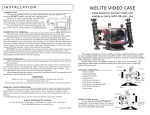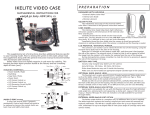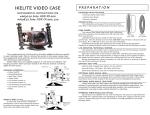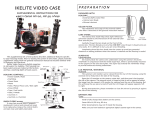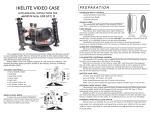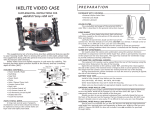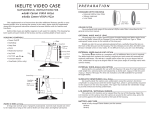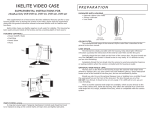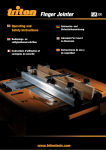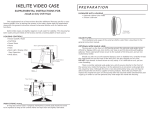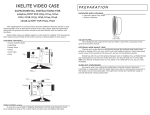Download Ikelite 6038.53 underwater camera housing
Transcript
I K E LI TE VI DE O C A S E PREPARATION S U P P L E M E N TA L I N S TR U C T I O N S F O R P A C K A G E D W I T H H O U S I NG _ _ _ _ _ _ _ _ _ _ _ _ _ _ _ _ _ _ _ _ _ _ _ _ _ _ _ _ _ _ _ _ _ _ _ _ _ _ _ _ _ _ _ _ _ _ # 60 3 9 . 2 2 S o n y H D R X R - 5 5 0 # 6 0 3 8 . 5 3 So n y H D R C X 5 5 0 • External UR/Pro Color Filter • Silicone Lubricant C O L OR F IL T E R _ _ _ _ _ _ _ _ _ _ _ _ _ _ _ _ _ _ _ _ _ _ _ _ _ _ _ _ _ _ _ _ _ _ _ _ _ The installation and usage of the external UR/Pro color filter is described in the general instruction manual. External Color Filter S U P E R- E Y E V I E W F IN D E R_ _ _ _ _ _ _ _ _ _ _ _ _ _ _ _ _ _ _ _ _ _ _ _ _ _ _ _ _ _ _ _ _ _ _ _ _ _ _ _ _ _ _ _ _ _ _ _ _ See exactly what the camera sees underwater using the cameras electronic viewfinder in conjunction with the Ikelite Super-Eye, which is permanently mounted in the eyeport on the clear back plate. The Super-Eye extends the viewfinder image to provide enhanced viewing underwater. Camera viewfinder will not power on while LCD is being used. #6038.21 Sony XR-500, 520 L C D M O N I TO R / E X T E R N A L M I R R O R _ _ _ _ _ _ _ _ _ _ _ _ _ _ _ _ _ _ _ _ _ _ _ _ _ _ _ _ _ _ _ _ _ _ _ _ _ _ This supplemental set of instructions describes additional features specific to your housing model. Prior to testing the system in the water, please read this supplement along with the general instruction manual to become familiar with its features and functions. Ikelite Video Cases are slightly negative in salt water for stability. This housing has been water pressure tested at the factory and has a working depth of 60m 200. HO USI N G CON T R OL S_ _ _ _ _ _ _ _ _ _ _ _ _ _ _ _ Lid Snap • Power On/Off • Start/Stop • Snap Shot / Photo • Power Zoom • LCD Screen Control #1 • LCD Screen Control #2 • LCD Reversing Circuit On/Off • LCD Screen Control #3 • Mode Button M A I N O -R I NG # 0 1 0 9 _ _ _ _ _ _ _ _ _ _ _ _ _ _ _ O-rings last several years if properly maintained. Control seals should not need to be replaced as long as the control shafts are kept clean and lightly lubricated. Mode Power Zoom Touch Pad Port Mirror Touch Pad Touch Pad Bottom Bar B A T TE R Y A N D T A P E _ _ _ _ _ _ _ _ _ _ _ _ _ _ _ _ _ _ _ _ _ _ _ _ _ _ _ _ _ _ _ _ _ _ _ _ _ _ _ _ _ _ _ _ _ _ _ _ _ _ _ _ _ _ Install a fully charged Sony battery on the camera: Sony NP-FV50, NP-FV60, NP-FV70, NP-FV100 Other brand batteries may not fit inside the housing. I N TE R N A L W I D E - A N G L E L E N S O P T I O N _ _ _ _ _ _ _ _ _ _ _ _ _ _ _ _ _ _ _ _ _ _ _ _ _ _ _ _ _ _ _ _ _ _ _ _ _ Special ports are available for use with the Raynox DCR-730 High Resolution wide-angle lens. Requires 37mm to 52mm step-up ring. Optional ports sold separately, dome port #9306 or flat lens port #9306.1. Raynox DCR-730 lens not included. Lens n o t available for purchase through Ikelite. W E I G H T O PT I O N S _ _ _ _ _ _ _ _ _ _ _ _ _ _ _ _ _ _ _ _ _ _ _ _ _ _ _ _ _ _ _ _ _ _ _ _ _ _ _ _ _ _ _ _ _ _ _ _ _ _ _ _ _ _ _ _ If additional weight is needed the following bases can be ordered. #9360.1 - 5 oz. weight #9360.2 - 1 lb. weight Base Snap Shot Eyeport Power On-Off/ LCD Reverse Circuit Mode The cameras LCD monitor can be viewed from the rear of the housing, using the external mirror featured on the side of the housing. Open the LCD monitor on the camera, rotate 180°, and then press it back against the side of the camera. The external mirror is hinged so that it can be opened to reflect the image from the cameras LCD monitor for viewing from the rear of the housing. During transportation, please remember to close the mirror by pressing it against the side of the housing or lid snap. P O W E R O N / O F F - I M A GE R E VE R S I N G C I R C U I T _ _ _ _ _ _ _ _ _ _ _ _ _ _ _ _ _ _ _ _ _ _ _ _ A single control on the housing operates both the Power ON/OFF and Image Reversing Circuit. Secure the camera to the tray and partially slide the camera and tray inside the housing so you can connect the cable from the Power/Image Reversing circuitry to the AV Out port on the camera. Pow er ON/ OFF S w it ch If the camera is OFF, hold the Power button down for one second to turn the camera ON. When turning the camera OFF, there is a 5-minute standby power down delay that occurs when the reversing circuit is ON during power down. To avoid the 5-minute power down delay, turn the Reversing Circuitry OFF and then hold the the Power button down for three seconds to turn the camera OFF. I m a g e Re v e r si ng Ci r c u i t The circuit reverses flips the image and words on the LCD screen so that when the image is reflected in the external mirror, it appears correct left-to-right. F u nc ti o n s L o c k e d O u t When the reversing circuit is ON, some camera functions may be locked out. To activate the locked out functions, temporarily turn the Reversing Circuit OFF, change the locked out function on the camera, and then turn the Reversing Circuit back ON. S t ill M od e When in Still Mode and full wide angle, the image may show vignetting shading in the corners. To correct, slightly zoom in on the image until vignetting disappears. F IN A L P RE P A RA T IO N _ _ _ _ _ _ _ _ _ _ _ _ _ _ _ _ _ _ _ _ _ _ _ _ _ _ _ _ _ _ _ _ _ _ _ _ _ _ _ _ _ _ _ _ _ _ _ _ _ _ _ _ _ Remove the lens cap and cord from the camera. Otherwise, they may interfere with the housing seal. The cameras auto focus feature is utilized underwater. For best results, move in close to your subject and use the wide angle range to shoot thru as little water as possible. The full zoom range is accessible underwater. Turn the cameraMs built-in flash OFF. Chart shows recommended initial settings underwater. C AM E R A Power On/Off Zoom Lever Focus Exposure Program AE Shutter Speed White Balance Steady Shot Built-in Flash L L L L L L L L L S E T T IN G Camera On Wide Angle Setting Auto Mode Auto Mode Auto Mode 1/60 Normal Auto Mode see section Off Off W H I T E B A LA N C E _ _ _ _ _ _ _ _ _ _ _ _ _ _ _ _ _ _ _ _ _ _ _ _ _ _ _ _ _ _ _ _ _ _ _ _ _ _ _ _ _ _ _ _ _ _ _ _ _ _ _ _ _ _ _ _ _ Initially set the white balance to Auto. Use the touch screen controls on the housing to change white balance. C o l o r F i l t e r : When using the color filter during the day, set camera white balance to Auto for 0-15 foot depth. For 15-80 foot depth, set white balance to Outdoor. V i de o - L i t e : When using optional Video Lite at NIGHT, set the camera white balance to the Indoor position. During the DAY, use the Outdoor setting for subjects beyond 4-5 feet and the Indoor setting for closer subjects. INSTALLATION C AM E R A T R AY _ _ _ _ _ _ _ _ _ _ _ _ _ _ _ _ _ _ _ _ _ _ _ _ _ _ _ _ _ _ _ _ _ _ _ _ _ _ _ _ _ _ _ _ _ _ _ _ _ _ _ _ _ _ _ _ _ _ _ _ The camera mounts to the tray, which extends from the back plate of the O’ring housing. D O N O T remove the tray from the back plate. Back Plate Position the camera against the two stabilizing pins on the tray and secure with the camera mounting bolt. The camera should fit easily on the tray and should be parallel with the sides of the tray. IN SER T IN G T H E CA MER A ___________________________ __________Camera ____Mounting _____Bolt ___ Stabilizing Pins Camera Tray Check that the oMring is clean and properly positioned on the lip of the clear housing back plate. Check that the lens shade is completely threaded into the camera. Once the camera is mounted to the tray as shown above, pull the housing controls out to provide clearance for installing the camera. Partially slide the camera into the housing so you can connect the reversing circuit cable to the AV Out port on the camera. When sliding the camera into the housing align the housings zoom control to accept the cameraMs zoom lever. Make sure the lens shade on the front of the camera fits into the port recess in the front of the housing. D O N O T force this installation; the camera and tray should slide easily into place so the housings back plate oMring is resting against the main housing body. In this position the lid snaps can be positioned over the lid hooks on the housing back plate and snapped into position to seal the housing. H O U S I NG C O N T R O L S _ _ _ _ _ _ _ _ _ _ _ _ _ _ _ _ _ _ _ _ _ _ _ _ _ _ _ _ _ _ _ _ _ _ _ _ _ _ _ _ _ _ _ _ _ _ _ _ _ _ _ _ _ Slide the housing controls back in place making sure they properly align with the camera functions. Operate each control to see how it works with the camera. Some controls such as start/stop will be used frequently. Other controls may seldom be utilized. Refer to your camera owners manual for the proper function of each camera control. Look thru the back to be sure that you can see into the viewfinder. When using the housing controls, especially the start/stop, do NOT use excessive force because you could damage the camera. CAU T IO N Remove the lens cap and cord from the camera. Otherwise, the cord may interfere with the housing seal. If the housing controls are not properly positioned, they could interfere with the housing seal. M AN U A L F O C U S O P E R A T I O N _ _ _ _ _ _ _ _ _ _ _ _ _ _ _ _ _ _ _ _ _ _ _ _ _ _ _ _ _ _ _ _ _ _ _ _ _ _ _ _ _ _ _ _ _ Manual focus may be preferred in low light levels or when the subject possesses little contrast. Set the focus pad on the LCD screen to Manual to cancel the auto focus. If you want to manually adjust the focus, rotate the manual focus control as desired. To reactivate the auto focus, set the focus pad on the LCD screen to Auto. I K E L I T E U N D E RW A T E R S Y S T E M S 50 West 33rd Street • PO Box 88100 • Indianapolis, IN 46208 USA • 317.923.4523 Email: [email protected] • www.ikelite.com 6039.22-01-0510


